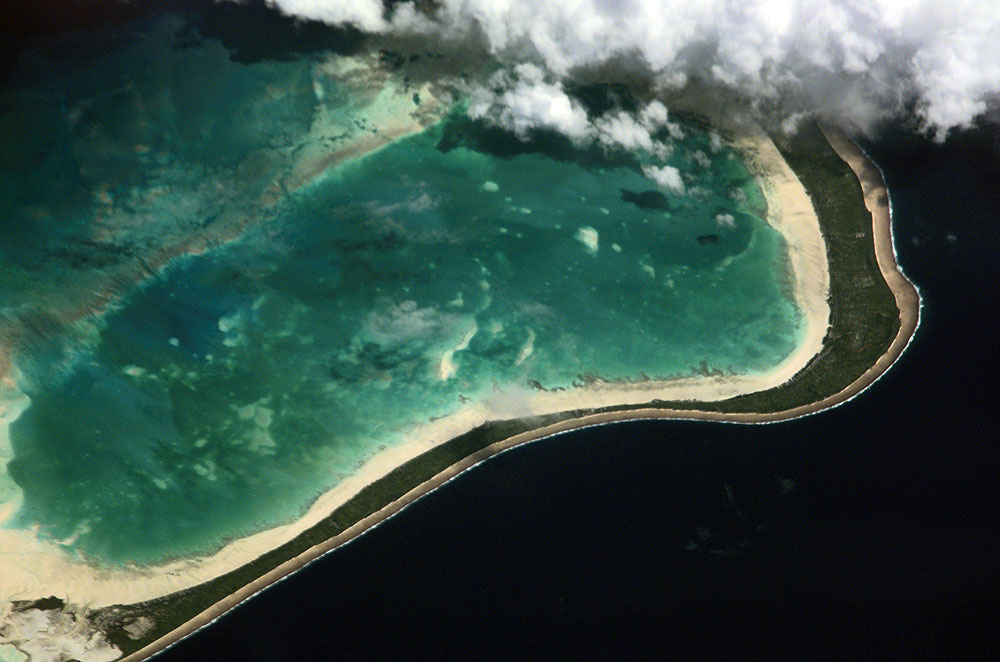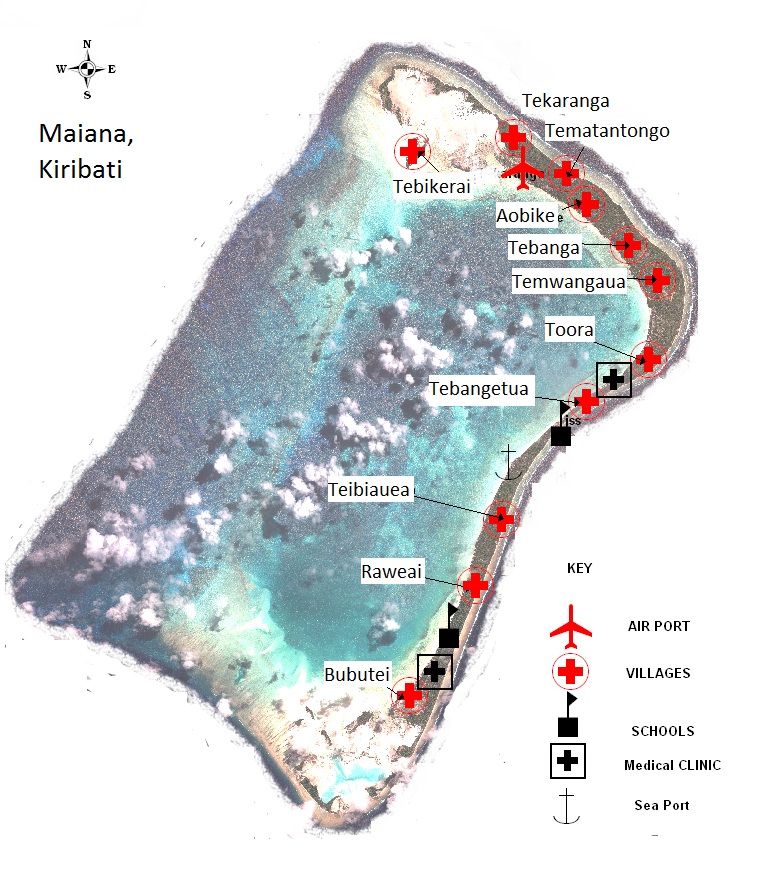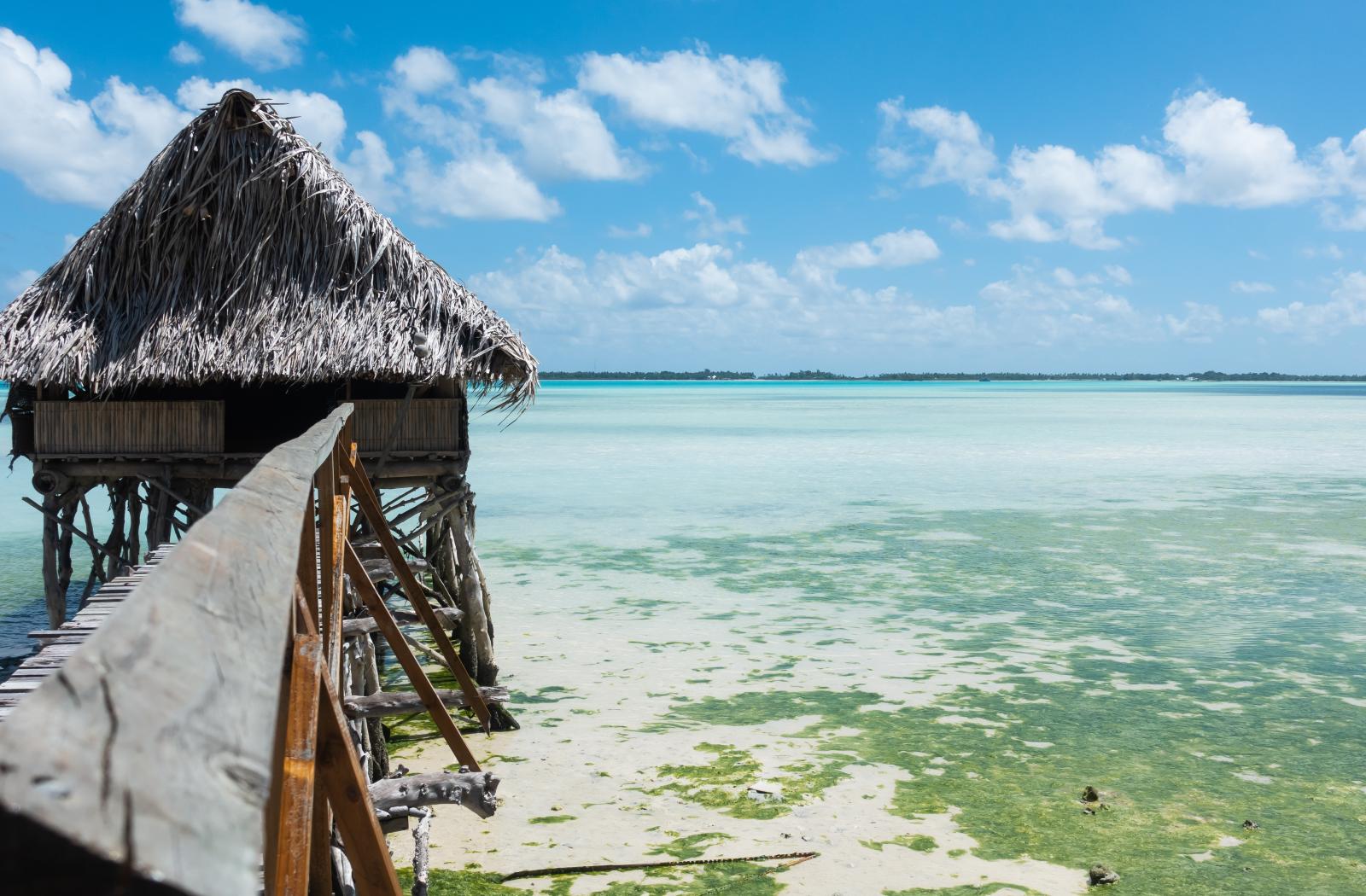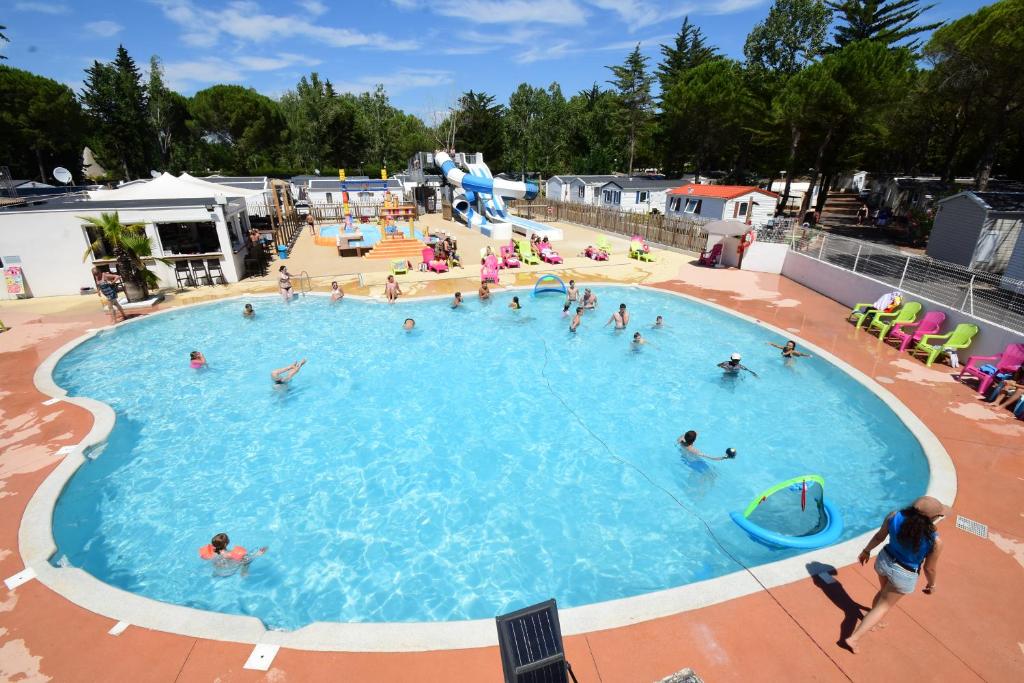Maiana Atoll: A Complete Guide To Its People, Culture, & Climate
Maiana is an island in the Kiribati Group's northern region. There are 1,685 people reported to live there, and its area is 15.9 square kilometers
Author:Sophia HarperReviewer:Liam JonesMay 18, 202550.4K Shares721.3K Views

Nestled in the heart of the Pacific Ocean, Maianais one of the lesser-known atolls in the Gilbert Islands chain of Kiribati. Despite its modest size, Maiana boasts a rich cultural heritage, unique environmental challenges, and a resilient community that offers valuable insights into the broader issues facing small island nations today.
Let's cover the various facets of Maiana, from its geographical features and demographic composition to its cultural practices, economic activities, and the pressing environmental concerns it faces. By exploring these aspects, we aim to provide a comprehensive understanding of Maiana's significance within Kiribati and the broader Pacific region.
Quick Facts About Maiana
| Location | Part of the North Gilbert Islands, Kiribati, in the Pacific Ocean. |
| Area | 16.72 km2 (6.46 sq mi) |
| Population (2020) | 2,345 people |
| Highest elevation | 3 m (10 ft) |
| Pop. density | 121/km2 (313/sq mi) |
| Ethnic groups | I-Kiribati 99.9% |
| Administration | Kiribati |
| Island group | Gilbert Islands |
1. Location And Geography
Precise Location
Maiana Atoll is strategically positioned within the North Gilbert Islands of the Republic of Kiribati, situated approximately 28 kilometers to the south of Tarawa, the nation's bustling capital island.
Atoll Formation
Exhibiting a remarkably elongated form, Maiana features a continuous, narrow stretch of land predominantly along its eastern and northeastern edges. Contrasting this, its western flank gradually dissolves into an intricate network of shallowly submerged reefs.
Dimensions
The atoll extends for a considerable length of about 14 kilometers (8.7 miles), while its width reaches a maximum of 9.5 kilometers, contributing to its characteristically slender appearance.
Lagoon And Islets
Enclosed by the arc of land and the submerged reefs lies a lagoon of moderate size, its tranquil surface occasionally punctuated by small coral islets that emerge at both the northern and southern extremities of the main island.
Fringing Reef
A vital, albeit narrow, fringing reef embraces the landmass, acting as a crucial natural barrier that buffers the island from the powerful swells and currents of the open ocean .
Low Elevation
Consistent with the topography of coral atolls worldwide, Maiana's terrain is generally low-lying, with an average elevation hovering around a modest 2 meters (approximately 6.5 feet) above the prevailing sea level.
2. Physical Environment And Natural Resources [Maiana Island Environment]
Soil And Vegetation
Blessed with a consistently high annual rainfall, Maiana boasts surprisingly fertile soil, a valuable asset in the often nutrient-poor environments of atolls. This rich substrate supports a diverse and verdant vegetation cover across the island.
Key Food Crops
The favorable climatic and soil conditions enable the thriving cultivation of essential food sources:
- Coconuts
- Giant taro (bwabwai)
- Pandanus
- Breadfruit
These crops often flourish with minimal intensive farming practices, underscoring the natural productivity of the land.
Swampy Agricultural Areas
Both naturally occurring and human-engineered swampy regions are utilized for agricultural purposes on Maiana, particularly for cultivating crops adapted to these waterlogged environments.
However, these low-lying areas are notably vulnerable to the intrusion of seawater, especially during periods of unusually high tides.
Freshwater Resources
The primary lifeline for Maiana's inhabitants is the underground freshwater lens [Freshwater Lens Atolls], a precious reservoir of potable water. This resource is accessed through numerous wells, typically ranging from 3 to 5 meters in depth.
Complementing this groundwater source are 38 rainwater catchment systems strategically placed across the atoll.
Water Quality Concerns
Maintaining the quality of Maiana's freshwater is an ongoing challenge, with several factors posing a threat:
- Contamination from open wells located near bwabwai pits.
- Saltwater intrusion into the groundwater, exacerbated by increasingly frequent unusually high tides.
- The risk of salinization during prolonged periods of drought.
3. Demographics: A Growing Yet Stable Community [Maiana Island Population]
Maiana has witnessed a notable increase in its population, rising from 1,982 residents in the 2015 census to 2,345 individuals in the 2020 census.
Despite this recent growth spurt, the overall population of Maiana has demonstrated remarkable stability over the long term, consistently remaining just above the 2,000 mark since the mid-1980s.
With a total land area of 17 square kilometers, Maiana exhibits a population density of approximately 119 people per square kilometer, ranking it as the 13th most densely populated island within the broader Kiribati archipelago.
Bubutei stands as the most populous village on Maiana, home to 506 residents as of the 2020 census. It serves as the central hub for administration and community services, housing the Island Council, the primary medical clinic, and the Junior Secondary School.
A significant constraint for the younger generation on Maiana is the absence of a secondary school. Consequently, students aged 15 to 19 who aspire to pursue education beyond the junior secondary level are compelled to leave the atoll to continue their academic journey elsewhere.
Related Reading: Micronesia - A Featureless Expanse Of Ocean Dotted With Islands
4. Population Composition: Age And Gender Dynamics [Maiana Demographics]
Age Distribution
- The largest demographic segment comprises individuals aged 18-49 years (42.69% of the total). Bubutei village has the highest concentration of residents within this age group.
- A substantial younger generation, aged 6-14 years (22.90% of the island's inhabitants).
- The age dependency group, encompassing those under 15 and over 64 years of age (39.20% of the population). Notably, the majority within this group (919 individuals) are children aged 0-14 [Child Population].
- Overall, Maiana is characterized by a relatively youthful population, with the majority of its residents being under the age of 50.
Gender Ratio:Based on the 2020 census data, Maiana exhibits a gender ratio of 99 males for every 100 females, with a total of 674 males and 682 females residing on the atoll.
Gender Imbalances in Specific Age Groups:Interestingly, females significantly outnumber males in the 30-34 year age bracket (100 females compared to only 69 males).
This trend is also observed in the older population, with a considerably higher number of women aged 65 and over compared to men in the same age group (61 older women versus 18 older men).
5. Climate: Equatorial Patterns And Environmental Challenges [Climate Of Kiribati]
Equatorial Climate
Maiana experiences a consistent equatorial climate characterized by high temperatures throughout the year and distinct wet (March-August) and dry (September-February) seasons.
Temperature Range
Daily temperatures typically fluctuate between a comfortable low of around 28° Celsius at dawn and a warmer high of approximately 31° Celsius in the early afternoon .
Importance Of Ocean Breezes
The constant presence of cooling ocean breezes plays a vital role in moderating the high temperatures, providing natural ventilation and relief during the hotter parts of the day.
Rainfall Data Scarcity
Unlike the more developed island of Tarawa, comprehensive rainfall data for Maiana and other outer islands remains limited due to the lack of dedicated meteorological measuring equipment.
Coastal Erosion
Many coastal areas of Maiana are experiencing significant coastal erosion, a pressing environmental concern [Coastal Erosion Pacific]. The villages of Tekaranga and Tematantongo are particularly affected by the relentless encroachment of the sea.
Drought Concerns
The atoll's heavy reliance on a shallow freshwater lens makes it highly vulnerable to prolonged periods of drought [Water Scarcity Atolls], during which the limited freshwater supply becomes increasingly susceptible to salinization, especially in coastal regions.
Sea Level Rise
As with all low-lying atolls across the globe, the ominous threat of rising sea levels poses a grave danger to the very existence of Maiana. Even seemingly minor increases in sea level can lead to accelerated coastal erosion and threaten vital infrastructure, productive agricultural lands, and the already precarious freshwater resources.
6. Culture, History, And Economy [Culture Of Kiribati]
Despite its relative proximity to the more urbanized Tarawa, Maiana retains a deeply rooted and relaxed traditional way of life, where community bonds and ancestral customs remain strong.
Economic Activities
While subsistence fishing forms a cornerstone of the local economy, residents also engage in other income-generating activities:
- Collection of sea cucumbers from the lagoon, a valuable commodity traded in Asian markets.
- Harvesting and processing of coconuts, a versatile resource used for food, animal feed, and fuel.
Myths And Legends
The rich cultural heritage of Maiana is interwoven with captivating myths and legends, most notably the story of spirits migrating northward from Samoa, carrying branches of Te Kaintikuaba, the sacred "tree of life" [Te Kaintikuaba Legend]. These spirits, in collaboration with the wise deity Nareau, are revered as the creators of the islands of Tungaru (the Gilbert Islands).
Historical Survey:Maiana's documented history with the Western world began in 1841 when it was meticulously surveyed by the United States Exploring Expedition.
Maiana Post Office:The establishment of a post office on Maiana around 1925 marked a significant step towards improved communication and connectivity with the outside world.
Maiana Ferry Disaster:The tragic capsizing of the Uean Te Raoi II ferry in 2009 off the coast of Maiana resulted in the heartbreaking loss of 35 lives, a profound event that left a lasting scar on the close-knit community
7. Flora And Fauna [Ecology Of Atolls]
While specific detailed studies on Maiana's unique biodiversity may be limited in readily available sources, atoll ecosystems generally feature a range of resilient flora and fauna adapted to the saline and often harsh conditions:
- Flora:Common vegetation includes various species of salt-tolerant shrubs, grasses [Salt-Tolerant Plants], and the ubiquitous coconut palms, which are vital for sustenance and the ecosystem. Pandanus trees are also a significant component of the vegetation.
- Fauna:Marine life in the lagoon and surrounding reefs is diverse, including numerous species of fish, crustaceans, and mollusks. Seabirds are also a prominent feature of atoll ecosystems, with various species using the islands as nesting sites [Bird Sanctuaries]. Terrestrial fauna is typically less diverse, often including insects [Island Insects], lizards, and potentially introduced species.
8. Administration And Governance [Governance Of Kiribati]
- Island Council:The administrative center for Maiana resides in Bubutei village, where the Island Council convenes to oversee local governance, public services, and community development initiatives.
- National Representation:Maiana's voice is articulated at the national level through its two elected members who serve in the Maneaba ni Maungatabu, Kiribati's national parliament, located on Tarawa.
- Traditional Unimwane System:Complementing the formal administrative structures is the esteemed traditional Unimwane system, a council of elders representing each of Maiana's villages. Led by the most senior member, the Baatua, this council plays a crucial role in preserving and upholding cultural traditions, mediating disputes within the community, and providing guidance rooted in ancestral wisdom and customs.
9. Tourism Potential
Maiana's pristine beaches, vibrant marine life, and rich cultural heritage present opportunities for eco-tourism development. Potential attractions include:
- Cultural Experiences: Participating in traditional ceremonies and learning about local customs.
- Marine Activities: Snorkeling, fishing, and exploring the lagoon's biodiversity.
However, tourism infrastructure is minimal, and sustainable development plans are necessary to balance economic benefits with environmental preservation.
FAQs About Maiana Atoll
Where Exactly Is Maiana Atoll Located Within The Kiribati Archipelago ?
Maiana Atoll is situated in the North Gilbert Islands of Kiribati, approximately 28 kilometers to the south of Tarawa.
What Are The Primary Sources Of Freshwater For The Residents Of Maiana?
The main sources of freshwater are the underground freshwater lens, accessed through numerous wells across the atoll, and rainwater harvested through 38 dedicated catchment systems.
What Are The Most Pressing Environmental Challenges Facing Maiana Atoll Today?
Maiana faces significant environmental challenges, primarily coastal erosion, the increasing risk of droughts leading to the salinization of its vital freshwater lens [Saltwater Intrusion Maiana], and the long-term existential threat posed by rising sea levels.
What Are The Key Economic Activities That Sustain The Communities On Maiana?
The primary economic activities include traditional fishing practices, the collection of sea cucumbers for commercial sale, and the harvesting and processing of coconuts for food, animal feed, and fuel.
What Educational Opportunities Are Available For The Youth Of Maiana?
Maiana offers education up to the Junior Secondary School level, located in Bubutei . Students wishing to pursue further education at the secondary level must leave the atoll to attend schools on other islands.
Conclusion
Maiana stands as a testament to the resilience and cultural richness of small island communities. While facing significant environmental and infrastructural challenges, the island's inhabitants continue to uphold their traditions and adapt to changing circumstances.
Addressing the pressing issues of climate change, economic development, and service provision requires concerted efforts from both local communities and international partners. With sustainable development and cultural preservation at the forefront, Maiana can continue to thrive as a unique and vibrant part of Kiribati's national tapestry.
Jump to
Quick Facts About Maiana
1. Location And Geography
2. Physical Environment And Natural Resources [Maiana Island Environment]
3. Demographics: A Growing Yet Stable Community [Maiana Island Population]
4. Population Composition: Age And Gender Dynamics [Maiana Demographics]
5. Climate: Equatorial Patterns And Environmental Challenges [Climate Of Kiribati]
6. Culture, History, And Economy [Culture Of Kiribati]
7. Flora And Fauna [Ecology Of Atolls]
8. Administration And Governance [Governance Of Kiribati]
9. Tourism Potential
FAQs About Maiana Atoll
Conclusion

Sophia Harper
Author
Sophia Harper’s photography acts as a portal to the soul of the places she visits. Drawn to South America’s landscapes and cultures, she has spent years capturing everything from the majesty of ancient ruins to the vibrancy of urban streets.
Sophia’s work isn’t just about documenting moments; it’s about evoking the emotions and stories behind them. A dedicated photographer, she has worked with local communities across South America to capture their rich cultural narratives through her lens.

Liam Jones
Reviewer
Liam Jones has made it his mission to prove that adventure doesn’t need a hefty budget. Having traveled to over 40 countries, he specializes in finding affordable ways to experience the world, from the best street food in Bangkok to hidden gems in Lisbon.
Liam’s travel tips have reached thousands of readers, empowering them to see the world on a shoestring budget without sacrificing quality. With a deep passion for local cultures, he continues to share his travel hacks, ensuring adventure remains accessible to all.
Latest Articles
Popular Articles


